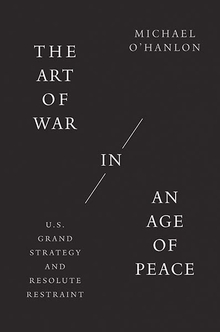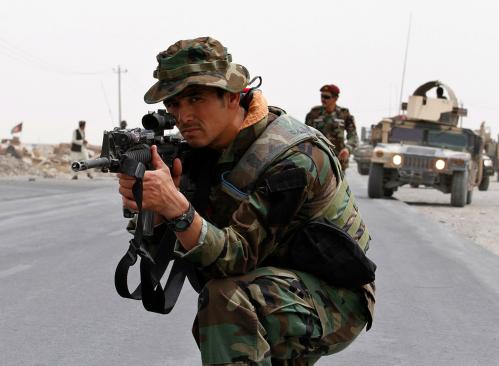In testimony on Capitol Hill on February 9, General John Nicholson, commander of the NATO-led mission in Afghanistan, described the war as “a stalemate,” and estimated that coalition forces have a “shortfall of a few thousand” troops in the country. On March 9, General Joseph Votel of Central Command backed up his Afghanistan commander, seconding his view that more coalition personnel might be needed—not as main combat troops, but as advisors.
Why, so far into what is already America’s longest war, are the nation’s top commanders calling for more forces in Afghanistan? (Realistically, many if not most of any added troops would probably have to be American, since our allies will not agree to a troop increase unless we lead the way.) It is a fair question. Many will wonder if we are simply reinforcing failure in what has been a long, frustrating, and bloody campaign. With an Afghan government still weak and often internally divided, a resilient insurgency enjoying some degree of sanctuary in Pakistan, 10 percent of the country in unfriendly hands and another 30 percent contested, and civilian casualties at an all-time high according to the United Nations, skepticism about the suggestion of General Nicholson and General Votel is understandable. The Trump administration itself has reportedly not yet decided if it agrees with its own generals—which is understandable, since its top national security team was not even fully formed when Nicholson testified. And Congress has not yet decided whether to fund any proposed increase, either.
State of play
We believe that the request of Nicholson and Votel makes sense. Before explaining its basis, however, it is worth summarizing the broader state of play in Afghanistan:
- The 8,400 or so U.S. troops in Afghanistan today do represent a substantial ongoing American commitment. The cost is not cheap either, perhaps $15 billion annually. But that troop total is down more than 90 percent from peak levels in the early Obama years. American casualties are down more than 95 percent.
- Afghan forces are doing most of the fighting, as they should be. All foreign troops in country total less than 15,000; Afghan forces exceed 300,000, after a nearly a decade of intensive efforts to build up their capacities. They are also sacrificing for their country, at the pace of nearly 10,000 fatalities a year. This terrible toll reflects, of course, the ongoing resiliency of the insurgency, and there are legitimate questions as to whether the Afghan police and army can sustain such losses without eventually collapsing. But let no one doubt their commitment to the struggle and their courage in waging it.
- While 10 percent of the country is indeed in enemy hands, according to U.S. intelligence, and some 30 percent contested, that means 60 percent—including all the nation’s large cities—are controlled by the government. This situation is not good enough. However, it also has not deteriorated that much since the early 2010s, even though NATO countries have now withdrawn 90 percent of their forces.
- The network of U.S. bases in Afghanistan helps us track and address threats from al-Qaida and ISIS in South Asia—threats which we have managed to contain and weaken using these bases.
The job still to be done
Back to the policy issue at hand. Although 8,400 U.S. troops in Afghanistan is a substantial number, their job has been complicated by the fact that U.S. and NATO troops were cut back too much and too soon in recent years. The mentoring and support operation that began in earnest when one of us, John Allen, commanded the NATO-led mission in Afghanistan needed more time and resources than it was allowed. Indeed, Allen recommended in 2013 that the long-term NATO commitment consist of 13,600 U.S. troops and another 6,000 from coalition partners. Allen’s Central Command commander, General James Mattis, supported this recommendation. Subsequent decisions produced too few troops on too short a timeline, and denied the Afghans key assistance such as the close air support they had previously been provided—and that they still needed, until their own air force was built.
The case for several thousand more troops centers on the idea of going back and completing the advisory and mentoring job that we had not nearly finished when the mission was downsized.
To be sure, there were understandable reasons that President Obama and other Western leaders chose to draw down NATO troops faster than commanders in the field recommended. They sought to spur the Afghan government to a greater sense of urgency, and reform, than it was displaying. But the predictable outcome of this decision was that many of the combat units of the Afghan army were left on their own too soon. They took greater casualties than they should have as a result, and this dynamic further slowed their development. The case for several thousand more troops centers on the idea of going back and completing the advisory and mentoring job that we had not nearly finished when the mission was downsized.
The Afghan army’s main combat formation is a “kandak” or battalion of about 800 soldiers. Several kandaks make a brigade, and several brigades make a corps. At present, Americans in Afghanistan work with the 7 corps of the army—mainly at their headquarters—but do not generally have the capacity to advise at lower echelons, closer to the fight (except with limited numbers of special forces).
At this stage of the war, we do not need to be with each of Afghanistan’s nearly 100 kandaks. Rather, we need to help those that are in the toughest fights or in the most delicate stages of reform and rebuilding. We also need to assist some well-chosen police units. Several dozen advisory teams, each made up of roughly 10 to 20 coalition troops and supported by logistics and rapid-response units, are the logical prescription for this situation. That adds up to an increase measured in the low thousands of troops, just as the generals have suggested.
So yes, it is probably logical that along with other initiatives, U.S. troop numbers and costs in Afghanistan should increase by one-third to one-half. And yes, casualties could rise somewhat too. But the deployment would still be quite modest compared with its earlier phases—and the added capabilities could well spell the difference between stalemate and a gradual trend toward something resembling victory.
The Brookings Institution is committed to quality, independence, and impact.
We are supported by a diverse array of funders. In line with our values and policies, each Brookings publication represents the sole views of its author(s).











Commentary
The case for a larger force in Afghanistan
March 14, 2017